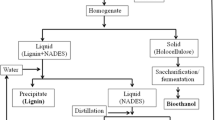Abstract
Ethanol production from concentrated oak wood hydrolysate was carried out to obtain a high ethanol concentration and a high ethanol yield. The effect of added inhibitory compounds, which are typically produced in the pretreatment step of steam-explosion on ethanol fermentation, was also examined. p-Hydroxybenzoic aldehyde, a lignin-degradation product, was the most inhibitory compound tested in this study. Compounds with additional methyl groups had reduced toxicity and the aromatic acids were less toxic than the corresponding aldehydes. The lignin-degradation products were more inhibitory than the sugar-derived products, such as furfural and 5-hydroxymethylfurfural (HMF). Adaptation of yeast cells to the wood hydrolysate and detoxification methods, such as using charcoal and overlime, had some beneficial effects on ethanol production using the concentrated wood hydrolysate. After treatment with charcoal and low-temperature sterilization, the yeast cells could utilize the concentrated wood hydrolysate with 170 as well as 140 g/L glucose, and produce 69.9 and 74.2 g/L ethanol, respectively, with a yield of 0.46–0.48 g ethanol/g glucose. In contrast, the cells could not completely utilize untreated wood hydrolysate with 100 g/L glucose. Low-temperature sterilization, with or without charcoal treatment, was very effective for ethanol production when highly concentrated wood hydrolysates were used. Low-temperature sterilization has advantages over traditional detoxification methods, such as using overlime, ion exchange, and charcoal, because of the reduction in the total cost of ethanol production.
Similar content being viewed by others
References
Lynd, L. R. (1990), Appl. Biochem. Biotechnol. 24–25, 695–719.
Ballerini, D., Desmarquest, J. P., Pourquie J., Native, F., and Rebeller, M. (1994), Bioresource Technol. 50, 17–23.
Olsson, L. and Hahn-Hägerdal, B. (1996), Enzyme Microb. Technol. 18, 312–331.
von Sivers, M. and Zacchi, G. (1996), Bioresource Technol. 56, 131–140.
Brownell, H. H., Yu, E. K. C., and Saddler, J. N. (1986), Biotechnol. Bioeng. 28, 792–801.
Shell, D. J., Torget, R., Power, A., Walter, P. J., Grohmann, K., and Hinman, N. D. (1991), Appl. Biochem. Biotechnol. 28–29, 87–97.
Ramos, L. P., Breuil, C., and Saddler, J. N. (1992), Appl. Biochem. Biotechnol. 34–35, 37–48.
Nunes, A. P., and Pourquie, J. (1996), Bioresource Technol. 57, 107–110.
Mes-Hartree, M., Hogan, C., Hayes, R. D., and Saddler, J. N. (1983), Biotechnol. Lett. 5, 101–106.
Mes-Hartree, M. and Saddler, J. N. (1983), Biotechnol. Lett. 5, 531–536.
Clark, T. A. and Mackie, K. L. (1984), J. Chem. Tech. Biotechnol. 34B, 101–110.
Ando, S., Arai, I., Kiyoto, K., and Hanai, S. (1986), J. Ferment. Technol. 64, 567–570.
Burtscher, E., Bobleter, O., Schwald, W., Concin, R., and Binder, H. (1987), J. Chromatogr. 390, 401–412.
Tran, A. V. and Chambers, R. P. (1985), Biotechnol. Lett. 11, 841–846.
Sanchez, B. and Bautista, J. (1988), Enzyme Microb. Technol. 10, 315–318.
Palmqvist, E., Hahn-Hägerdal, B., Galbe, M., and Zacchi, G. (1996), Enzyme Microb. Technol. 19, 470–476.
Ranatunga, T. D., Jervis, J., Helm, R. F., McMillan, J. D., and Hatzis, C. (1997), Appl. Biochem. Biotechnol. 67, 185–198.
Chung, I. S. and Lee, Y. Y. (1985), Biotechnol. Bioeng. 27, 308–315.
Parajo, J. C., Dominguez, H., and Dominguez, J. M. (1996), Bioresource Technol. 57, 179–185.
Rivard, C. J., Engel, R. E., Hayward, T. K., Nagle, N. J., Hatzis, C., and Philippidis, G. P. (1996), Appl. Biochem. Biotechnol. 57–58, 183–191.
Palmqvist, E., Hahn-Hägerdal, B., Szengyel, Z., Zacchi, G., and Reczey, K. (1997), Enzyme Microb. Technol. 20, 286–293.
Ghose, T. K. (1987), Pure Appl. Chem. 59, 257–268.
Banerjee, N., Bhatnagar, R., and Viswanathan, L. (1981), Enzyme Microb. Technol. 3, 24–28.
Banerjee, N. and Viswanathan, L. (1981), Eur. J. Appl. Microbiol. Biotechnol. 11, 226–228.
Author information
Authors and Affiliations
Corresponding author
Rights and permissions
About this article
Cite this article
Lee, W.G., Lee, J.S., Shin, C.S. et al. Ethanol production using concentrated oak wood hydrolysates and methods to detoxify. Appl Biochem Biotechnol 78, 547–559 (1999). https://doi.org/10.1385/ABAB:78:1-3:547
Issue Date:
DOI: https://doi.org/10.1385/ABAB:78:1-3:547




